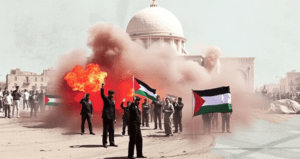Amid War, Israelis & Palestinians Demand Change: 3 Shocking Revelations Shaping the Conflict
As the devastating war between Israel and Hamas continues, both Israelis and Palestinians are taking to the streets, demanding change. In Israel, thousands are protesting against Prime Minister Benjamin Netanyahu, urging him to end the war, secure the release of hostages, and reverse judicial reforms. Despite public outrage, Netanyahu has managed to maintain power through political maneuvering. Meanwhile, rare protests in Gaza signal growing frustration with Hamas, as some citizens openly criticize the group’s leadership.
A recent survey shows declining support for Hamas in Gaza, with many blaming it for their suffering. Israeli officials see this as a sign of Hamas losing control, while Hamas dismisses the protests as Israeli propaganda. Adding to the tension, U.S. President Donald Trump has proposed relocating Gaza’s population and transforming the region into a luxury destination—a plan widely condemned by the international community. With both Netanyahu and Hamas unwilling to compromise, a lasting peace remains uncertain.

Amid War, Israelis & Palestinians Demand Change: 3 Shocking Revelations Shaping the Conflict
As the devastating war between Israel and Hamas continues, citizens on both sides are increasingly voicing frustration with their leaders. Protests have erupted in Israel and Gaza, with demonstrators demanding accountability and change. While each side points to the other’s unrest as proof of their own political stance, neither government shows signs of backing down.
Israeli Protests Target Netanyahu’s Leadership
In Israel, thousands have taken to the streets to protest Prime Minister Benjamin Netanyahu’s handling of the war. Demonstrators are calling for an immediate ceasefire, the safe return of hostages held by Hamas, and the withdrawal of a contentious judicial reform bill that critics argue would weaken the courts. Families of hostages have joined the protests, accusing Netanyahu’s government of neglecting their loved ones’ safety in favor of military objectives.
The protests reflect broader discontent with Netanyahu, who faces ongoing legal battles over corruption charges, accusations of dismissing intelligence officials who warned of Hamas’ October 7 attack, and alliances with far-right politicians pushing aggressive policies. Despite public anger, analysts note Netanyahu has so far retained power through political deals and coalition agreements.
Israeli officials argue the demonstrations highlight the country’s vibrant democracy. Yet critics warn that Netanyahu’s government is growing detached from public concerns, prioritizing political survival over meaningful dialogue. This divide, they say, threatens Israel’s democratic foundations.
Gaza’s Rare Anti-Hamas Demonstrations
In Gaza, public criticism of Hamas—a rare occurrence under the group’s authoritarian rule—has surfaced. Small protests have seen residents chant, “Hamas does not represent us,” voicing anger over the severe humanitarian crisis caused by the war. Israeli leaders have seized on these protests, claiming they signal Hamas’ declining influence.
A recent survey by the Palestinian Center for Policy and Survey Research found that support for Hamas’ war strategy in Gaza has plummeted. Many Gazans blame the group for provoking the conflict and failing to protect civilians, accusing it of using residential areas for military purposes. However, Hamas dismisses the demonstrations as “Israeli propaganda,” insisting it remains committed to resisting occupation.
Trump’s Controversial Gaza Proposal Draws Backlash
Internationally, former U.S. President Donald Trump has faced criticism for his approach to the conflict. After initially brokering a temporary ceasefire, his administration later greenlit Israel’s resumption of military operations. More controversially, Trump has proposed relocating Gaza’s two million residents and transforming the territory into a luxury resort—a plan condemned globally as unrealistic and inhumane.
Analysts argue that while Gazans’ frustration with Hamas is real, it does not translate to support for Trump’s radical vision. Instead, they emphasize that lasting peace requires a political solution ensuring equal rights and security for both Israelis and Palestinians. However, with Netanyahu refusing to negotiate a Palestinian state and Hamas rejecting coexistence with Israel, prospects for dialogue remain bleak.
A Path Forward?
The growing unrest in Israel and Gaza underscores a shared desire for leadership that prioritizes people over politics. For Israelis, this means a government willing to end the war and address domestic concerns like judicial overreach. For Palestinians, it means leaders who can alleviate suffering while pursuing realistic diplomatic goals.
Yet with both sides entrenched in their positions, the cycle of violence and distrust persists. International bodies and human rights groups continue urging third-party mediation, humanitarian aid, and a renewed focus on a two-state solution. Until leaders on all sides commit to compromise, the hope for peace remains distant—leaving civilians to bear the war’s heaviest costs.
In the end, the protests reveal a common truth: Ordinary Israelis and Palestinians alike are exhausted by decades of conflict. Their cries for change, though met with resistance, highlight the urgent need for leaders willing to listen—and act.
You must be logged in to post a comment.